The HTC One M9 Review: Part 2
by Joshua Ho on April 6, 2015 10:00 AM EST- Posted in
- Smartphones
- HTC
- Qualcomm
- Mobile
- Snapdragon 810
- One M9
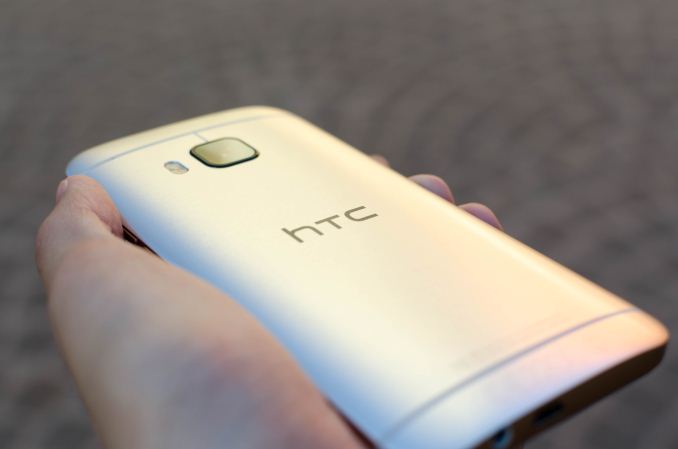
Read First: The HTC One M9 Review Part 1
A good amount of time ago, we posted part one of our HTC One M9 review, which gave a good idea of some critical aspects of the One M9’s performance and design. Unfortunately, due to HTC’s last minute software changes there was a need to redo some of our testing as the changes were quite significant for some key aspects of the user experience, which were effectively any situation where the SoC was in a thermally throttled situation and overall camera performance. I’ve finally finished redoing our testing of the One M9, so we can finish the review and get the full picture of the One M9’s performance. Normally, we’d start by discussing the design of the phone, but much of the review has already been finished with part one. Instead, we’ll start with sustained battery life tests.
Battery Life Continued
As previously detailed, our sustained battery life tests either strongly stress the CPU or GPU. For our GPU tests, we use GFXBench 3.0’s sustained GPU test, which runs the T-Rex benchmark on the display at its native resolution for an infinite rundown test. We didn’t have the modified test to present for a comparison between the two software builds, but we can get a pretty good sense for the changes that have occurred for final shipping software.
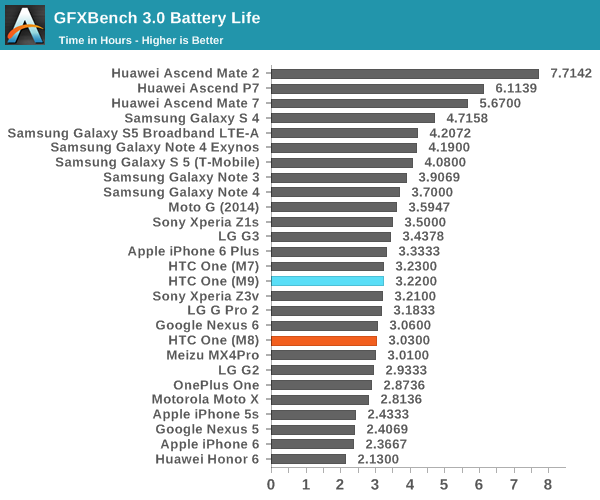
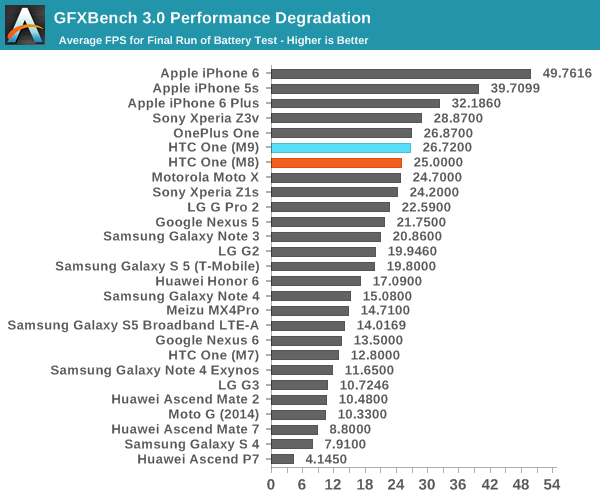
As one can see, the One M9 delivered somewhat impressive sustained performance with the pre-release build, but this resulted in almost dangerous skin temperatures and poor battery life on the order of 1.73 hours. The new update produced acceptable skin temperatures, but frame rate drops rather dramatically as skin temperature rises. The end performance actually ends up being quite similar to the One M8, but performance during the test is much higher than what we saw on the One M8.
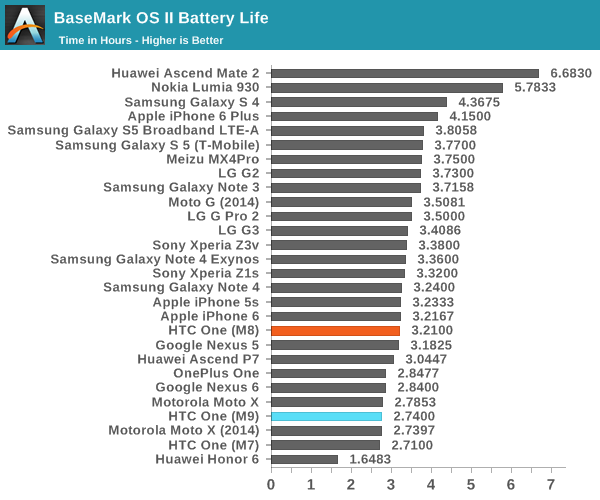

In the Basemark OS II test, we can see that the One M9 seems to perform poorly. One might be able to argue that the A57s provide more performance, but simple logging shows that past the first 20 minutes the A57 cluster is either shut down or throttled to the minimum clock state, although the A53 cluster manages to stay at 1.56 GHz for the duration of the test. For reference, the One M8 manages to keep the active CPUs at around 1.5 GHz throughout the test.
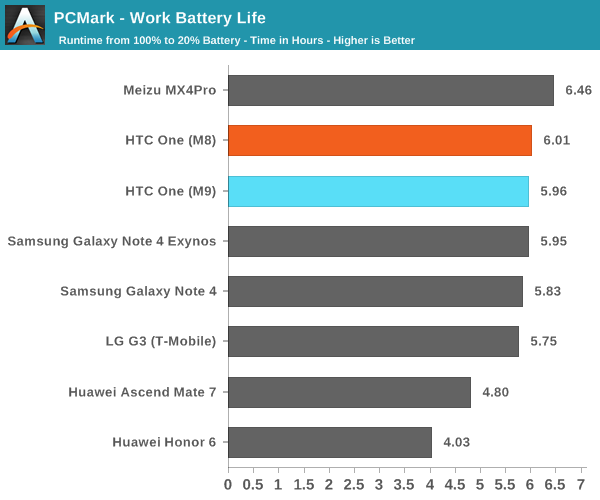
While Basemark OS II and GFXBench function as power virus tests, I wanted to get a good idea of performance somewhere between these rather extreme tests and the mostly display-bound web browsing test. To do this, I tested a few devices against PCMark’s work battery life benchmark, which shows that the One M9 seems to perform comparably when compared against the One M8. There is a noticeable difference in performance, but the gap isn’t all that big when compared to the M8. More interestingly is that the battery temperature sensor (which isn't necessarily on the battery) gets noticeably higher than the M8, on the order of 5-10C higher.
It’s a bit frightening to see that the gap in performance that we saw with the web browsing test remain. The effects of panel-self refresh would be greatly reduced in these short-running tests, so the differences here are mostly due to the SoC. The level of throttling I’ve seen here is pretty much unprecedented, which doesn’t help with the issue. Overall, the performance of Snapdragon 810 here is bad enough that I would genuinely consider Snapdragon 805 to be an improvement. I can’t help but wonder if this was inevitable though, as leaked roadmaps in the past suggested that Snapdragon 810 would’ve been a very different SoC.


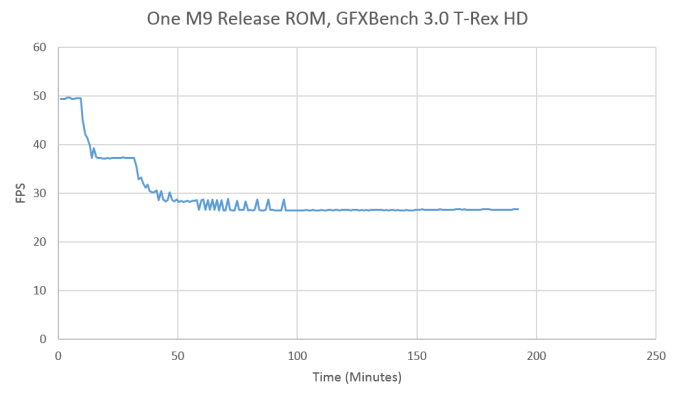
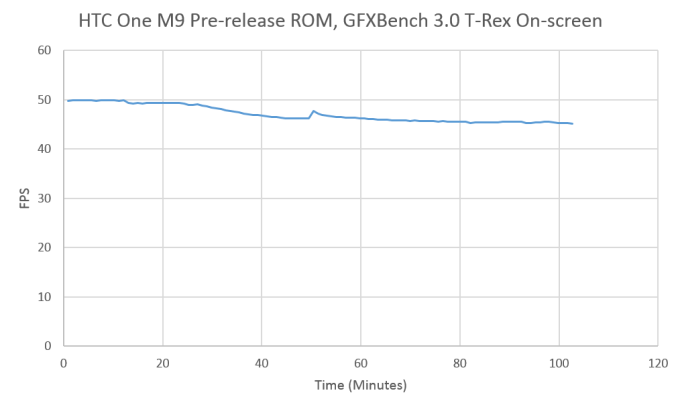








127 Comments
View All Comments
nismotigerwvu - Monday, April 6, 2015 - link
This is quite sad really. Both the HTC devices I've owned (going way back for the 1st with a Windows Mobile 6 packing Mogul/Titan and more recently the OG Evo) have been fantastic pieces of hardware. Perhaps some continued firmware tweaks can bring the camera performance back around, but the SoC really seems to be dragging the model down. Maybe even a midcycle refresh, like and M8+ with a better suited SoC. I haven't looked into it in awhile, but at least a few months ago there were rumors floating around of a new model that massaged the power usage a bit, I think it was being referred to as an 815 but this is purely off memory.DanNeely - Monday, April 6, 2015 - link
Qualcomm is denying that there was ever such a thing as an 815 on their roadmap; and is putting the 820 on the roadmap for retail availability at the end of this/start of next year.http://www.fudzilla.com/news/mobile/37406-there-is...
Laxaa - Monday, April 6, 2015 - link
I really wonder how the rest of this years Snapdragon 810 devices will perform. The LG G4 is even rumored to be using the 808 instead, due to the issues with the G Flex 2.jjj - Monday, April 6, 2015 - link
It's all good, Qualcomm will provide free cases with 60mm USB powered fans for every phone with Snapdragon810.As an alternative they'll also sell phase-change cooling backpacks.
Frenetic Pony - Monday, April 6, 2015 - link
A large part is the Cortex a57 and a53 cores. By all the looks of it Qualcomm could, and should, have stuck with their increasingly aging Snapdragon cores, shrunk the process to TSMC or Samsung's 20nm, and gottent better perf/battery life out it.blanarahul - Monday, April 6, 2015 - link
While it is true that the S810 would have been better with Krait, you have to consider the fact that ARM had already optimized the A57 and A53 cores for 20 nm and Qualcomm would have had to spend additional resources to get Krait to work well on 20 nm which would:-a) Ended up delaying Krait's ARMv8 successor.
b) Not be as efficient because a lot of improvements in Krait 400/300 came from the fact that 28 nm was a mature process and Qualcomm was used to it.
blanarahul - Monday, April 6, 2015 - link
You have to blame HTC to really. They should have compensated for S810 by including panel self refresh and a bigger battery but noooo, they want to make the phone as cheap as possible (display isn't well calibrated remember) and sell well for 700$. Sorry HTC, you aren't getting much money this year.Gunbuster - Tuesday, April 7, 2015 - link
but but but R&D costs money, blah blah blah...Nope they slap the same commodity SOC, screen, battery, and camera together just like everyone else these days. The $600+ phone gravy train is running off the tracks.
skavi - Wednesday, April 8, 2015 - link
They did add a larger battery.TylerGrunter - Tuesday, April 7, 2015 - link
The Krait cores were only competitive against A15 cores due to their ability to run at higher frequency. The issue with that is that 20nm in TSM they only had LPE, which seems to be terrible at high frequency, so they needed to use cores with higher IPC or there would be a huge performance regression and a terrible comparison with A57 cores.